FluView Summary ending on October 9, 2021

Note: CDC is tracking the COVID-19 pandemic in a weekly publication called COVID Data Tracker Weekly Review.
All data are preliminary and may change as more reports are received.
A description of the CDC influenza surveillance system, including methodology and detailed descriptions of each data component is available on the surveillance methods page.
Additional information on the current and previous influenza seasons for each surveillance component are available on FluView Interactive.
Seasonal influenza activity in the United States remains low.
Viruses
Severe Disease
All data are preliminary and may change as more reports are received.
A description of the CDC influenza surveillance system, including methodology and detailed descriptions of each data component is available on the surveillance methods page.
Additional information on the current and previous influenza seasons for each surveillance component are available on FluView Interactive.
Key Points
- An annual flu vaccine is the best way to protect against flu and its potentially serious complications.
- CDC recommends everyone 6 months or older get a flu vaccine by the end of October.
- There also are flu antiviral drugs that can be used to treat flu illness.
U.S. Virologic Surveillance:
Clinical Laboratories
The results of tests performed by clinical laboratories nationwide are summarized below. Data from clinical laboratories (the percentage of specimens tested that are positive for influenza) are used to monitor whether influenza activity is increasing or decreasing.
| Week 39 | Week 40 | |
|---|---|---|
| No. of specimens tested | 41,539 | 28,951 |
| No. of positive specimens (%) | 48 (0.1%) | 42 (0.1%) |
| Positive specimens by type | ||
| Influenza A | 24 (50.0%) | 24 (57.1%) |
| Influenza B | 24 (50.0%) | 18 (42.9%) |
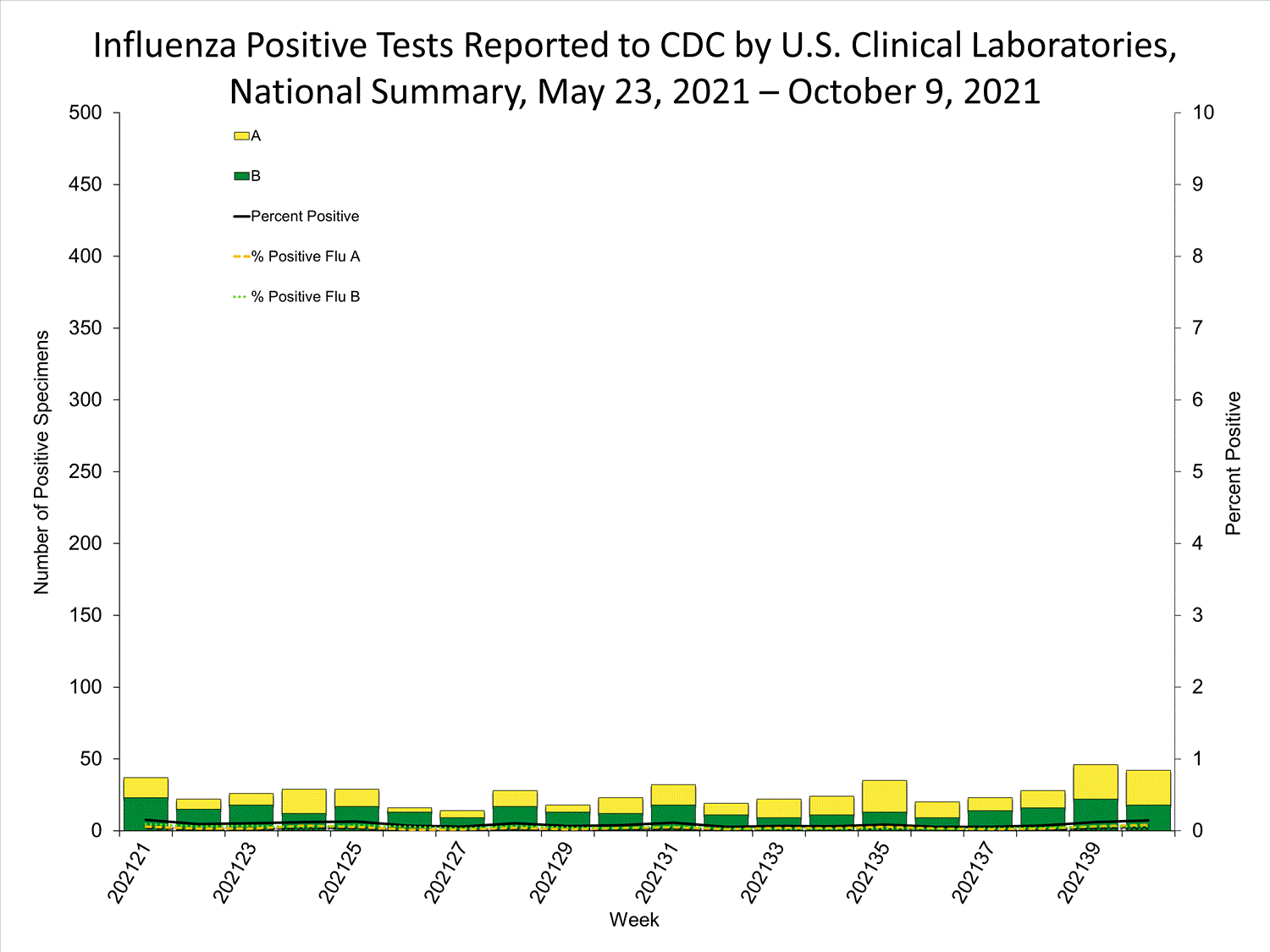
View Chart Data | View Full Screen
Public Health Laboratories
The results of tests performed by public health laboratories nationwide are summarized below. Data from public health laboratories are used to monitor the proportion of circulating viruses that belong to each influenza subtype/lineage.
| Week 39 | Week 40 | |
|---|---|---|
| No. of specimens tested | 17,400 | 14,615 |
| No. of positive specimens | 5 | 13 |
| Positive specimens by type/subtype | ||
| Influenza A | 3 (60.0%) | 8 (61.5%) |
| (H1N1)pdm09 | 0 | 1 (50.0%) |
| H3N2 | 2 (100%) | 1 (50.0%) |
| Subtyping not performed | 1 | 6 |
| Influenza B | 2 (40.0%) | 5 (38.5%) |
| Yamagata lineage | 1 (100%) | 0 |
| Victoria lineage | 0 | 1 (100%) |
| Lineage not performed | 1 | 4 |
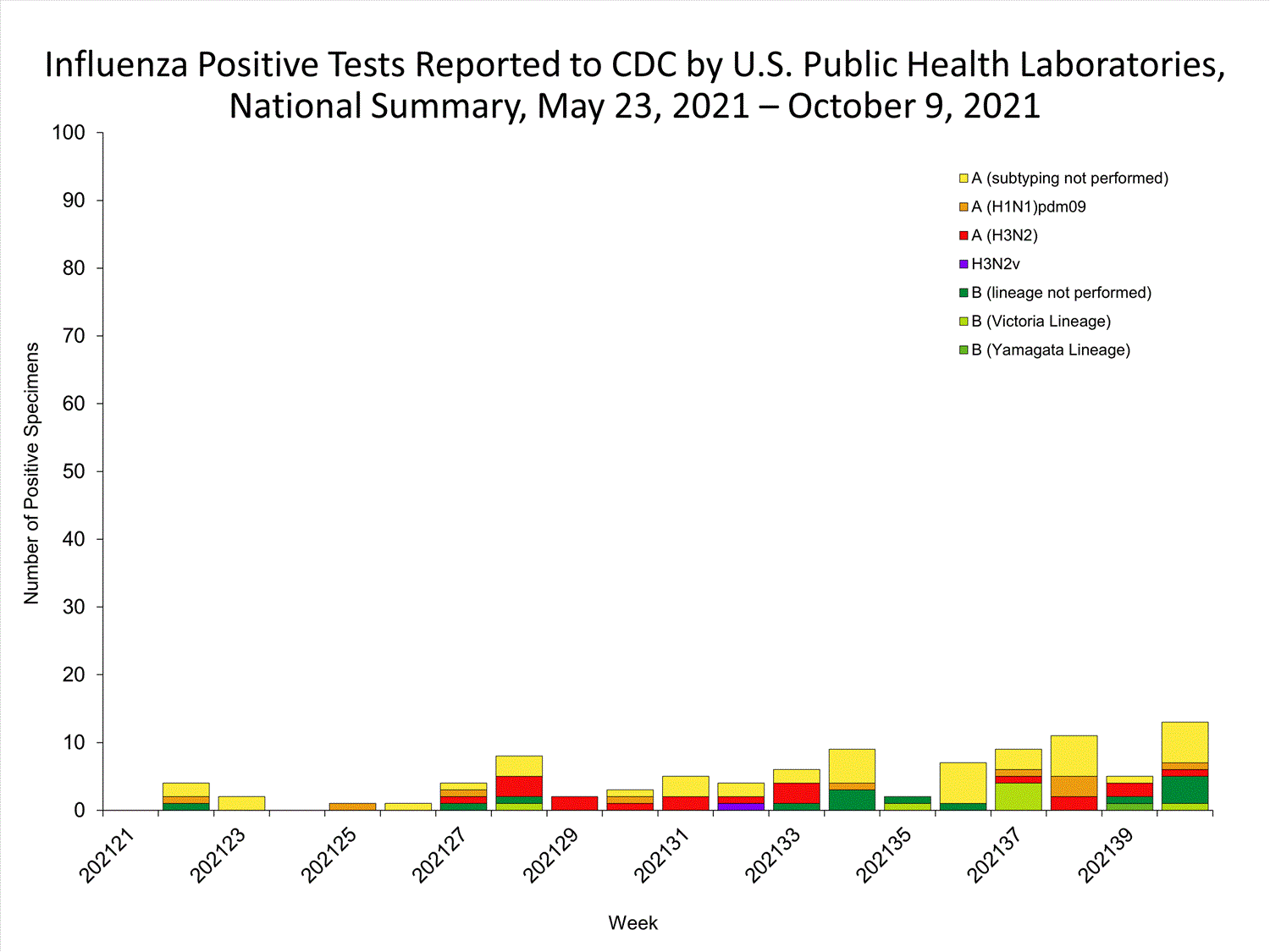
View Chart Data | View Full Screen
Additional virologic surveillance information for current and past seasons:
Surveillance Methods | FluView Interactive: National, Regional, and State Data or Age Data
Influenza Virus Characterization
CDC performs genetic and antigenic characterization of U.S. viruses submitted from state and local health laboratories using Right Size Roadmap submission guidance. These data are used to compare how similar the currently circulating influenza viruses are to the reference viruses representing viruses contained in the current influenza vaccines and to monitor evolutionary changes that continually occur in influenza viruses circulating in humans. CDC also tests susceptibility of influenza viruses to antiviral medications including the neuraminidase inhibitors (oseltamivir, zanamivir, and peramivir) and the PA endonuclease inhibitor baloxavir.
Virus characterization data will be updated later this season when a sufficient number of specimens have been tested.
Outpatient Illness Surveillance
The U.S. Outpatient Influenza-like Illness Surveillance Network (ILINet) monitors outpatient visits for influenza-like illness [(ILI) fever plus cough or sore throat], not laboratory-confirmed influenza, and will capture visits due to other respiratory pathogens, such as SARS-CoV-2, that present with similar symptoms. Due to the COVID-19 pandemic, health care-seeking behaviors have changed and people may be accessing the health care system in alternative settings not captured as a part of ILINet or at a different point in their illness than they might have before the pandemic. Therefore, it is important to evaluate syndromic surveillance data, including that from ILINet, in the context of other sources of surveillance data to obtain a complete and accurate picture of influenza, COVID-19, and other respiratory virus activity. CDC is tracking the COVID-19 pandemic in a weekly publication called COVID Data Tracker Weekly Review. Information about other respiratory virus activity can be found on CDC’s National Respiratory and Enteric Virus Surveillance System (NREVSS) website.
Effective October 3, 2021, the ILI definition (fever plus cough or sore throat) no longer includes “without a known cause other than influenza.” This change was made to improve the consistency with which the definition is applied across reporting sites
ILINet
Nationwide during week 40, 1.9% of patient visits reported through the U.S. Outpatient Influenza-like Illness Surveillance Network (ILINet) were due to influenza-like illness (ILI). This percentage is below the national baseline of 2.5%. Three regions (Region 2, Region 3, and Region 7) are at their region-specific baseline while the remaining regions are below their baselines. Overall, influenza virus circulation remains low; therefore, increases in ILI activity are likely due to increased circulation of other respiratory viruses.

View Chart Data (current season only) | View Full Screen
ILI Visits by Age Group
More than 70% of ILINet participants provide both the number of patient visits for ILI and the total number of patient visits for the week broken out by age group. Data from this subset of providers are used to calculate the percentages of patient visits for ILI by age group.
The percentages of visits for ILI reported in ILINet in week 40 remained stable compared to week 39 for all age groups (0–4 years, 5–24 years, 25–49 years, 50–64 years, and 65+ years) and is showing a decreasing trend over at least the past four weeks for all age groups.

View Chart Data | View Full Screen
ILI Activity Map
Data collected in ILINet are used to produce a measure of ILI activity* by state/jurisdiction and Core Based Statistical Areas (CBSA).
| Activity Level | Number of Jurisdictions | Number of CBSAs | ||
|---|---|---|---|---|
| Week 40
(Week ending |
Week 39
(Week ending |
Week 40
(Week ending |
Week 39
(Week ending |
|
| Very High | 1 | 0 | 1 | 0 |
| High | 0 | 0 | 3 | 7 |
| Moderate | 1 | 1 | 22 | 18 |
| Low | 5 | 9 | 91 | 77 |
| Minimal | 48 | 43 | 503 | 485 |
| Insufficient Data | 0 | 2 | 309 | 342 |
*Data collected in ILINet may disproportionally represent certain populations within a jurisdiction or CBSA, and therefore, may not accurately depict the full picture of influenza activity for the entire jurisdiction or CBSA. Differences in the data presented here by CDC and independently by some health departments likely represent differing levels of data completeness with data presented by the health department likely being the more complete.
Additional information about medically attended visits for ILI for current and past seasons:
Surveillance Methods | FluView Interactive: National, Regional, and State Data or ILI Activity Map
Long-term Care Facility (LTCF) Surveillance
LTCFs (e.g., nursing homes/skilled nursing, long-term care for the developmentally disabled, and assisted living facilities) from all 50 states and U.S. territories report data on influenza infections among residents the NHSN Long-term Care Facility Component. During week 40, 18 (0.13%) of 14,297 reporting LTCFs reported at least one laboratory-confirmed influenza test among their residents.

View Chart Dataexcel icon | View Full Screen
Additional information about long-term care facility surveillance:
Surveillance Methods | Additional Dataexternal icon
Hospitalization Surveillance
FluSurv-NET
The Influenza Hospitalization Surveillance Network (FluSurv-NET) conducts population-based The Influenza Hospitalization Surveillance Network (FluSurv-NET) conducts population-based surveillance for laboratory-confirmed influenza-related hospitalizations in select counties in 14 states and represents approximately 9% of the U.S. population. FluSurv-NET estimated hospitalization rates will be updated weekly starting later this season.
Additional FluSurv-NET hospitalization surveillance information for current and past seasons and additional age groups:
Surveillance Methods | FluView Interactive
HHS-Protect Hospitalization Surveillance
Hospitals report to HHS-Protect the number of patients admitted with laboratory-confirmed influenza. During week 40, 276 patients with laboratory-confirmed influenza were admitted to the hospital.
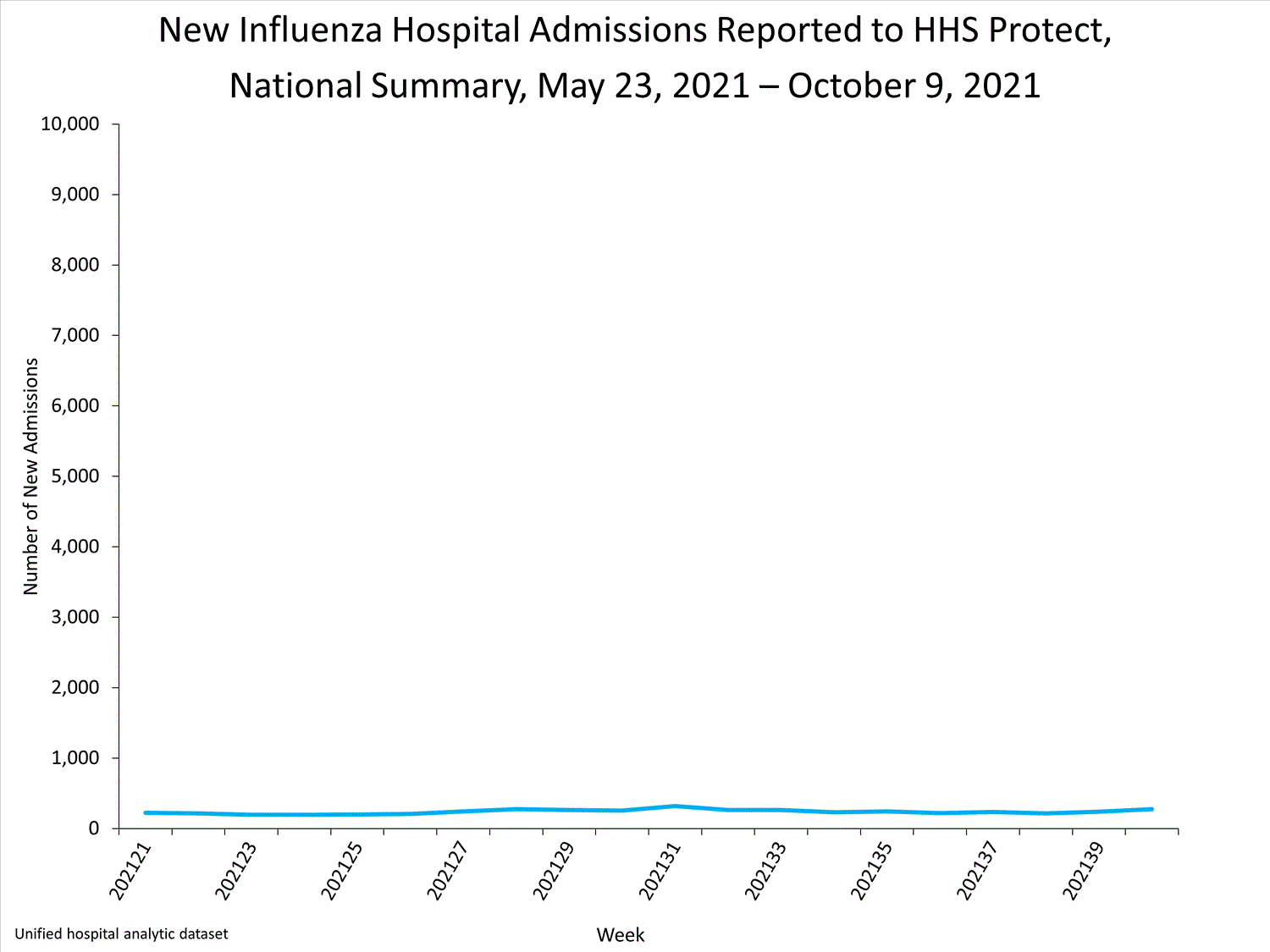
View Chart Dataexcel icon | View Full Screen
Additional HHS Protect hospitalization surveillance information:
Surveillance Methods | Additional Dataexternal icon
Mortality Surveillance
National Center for Health Statistics (NCHS) Mortality Surveillance
Based on NCHS mortality surveillance data available on October 14, 2021, 18.0% of the deaths that occurred during the week ending October 9, 2021 (week 40), were due to pneumonia, influenza, and/or COVID-19 (PIC). This percentage is above the epidemic threshold of 5.7% for this week. Among the 3,102 PIC deaths reported for this week, 2,430 had COVID-19 listed as an underlying or contributing cause of death on the death certificate, and two listed influenza, indicating that current PIC mortality is due primarily to COVID-19 and not influenza. The data presented are preliminary and may change as more data are received and processed.
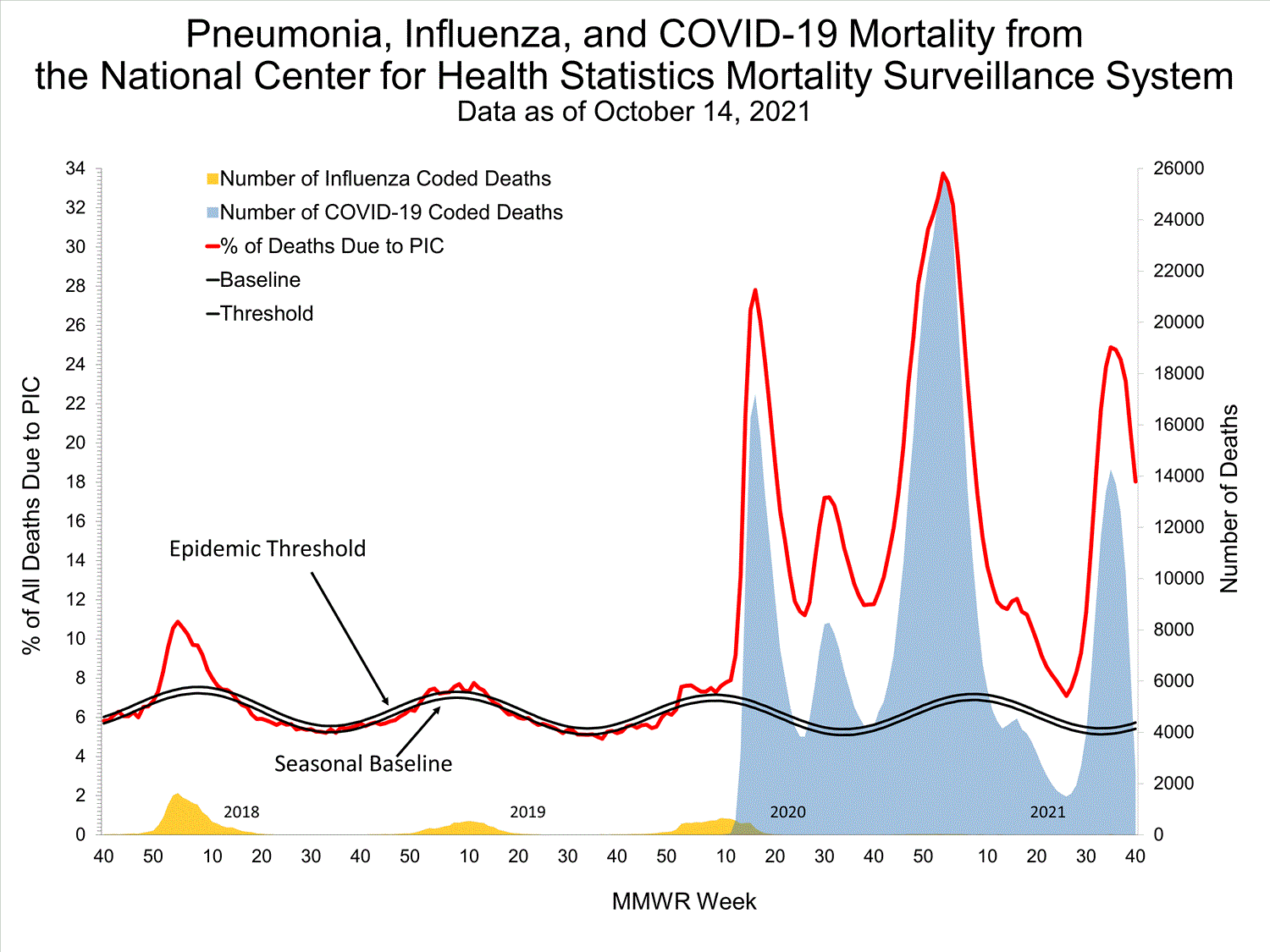
View Chart Dataexcel icon | View Full Screen
Additional pneumonia, influenza and COVID-19 mortality surveillance information for current and past seasons:
Surveillance Methods | FluView Interactive
Influenza-Associated Pediatric Mortality
No influenza-associated pediatric deaths occurring during the 2021-2022 season have been reported to CDC.
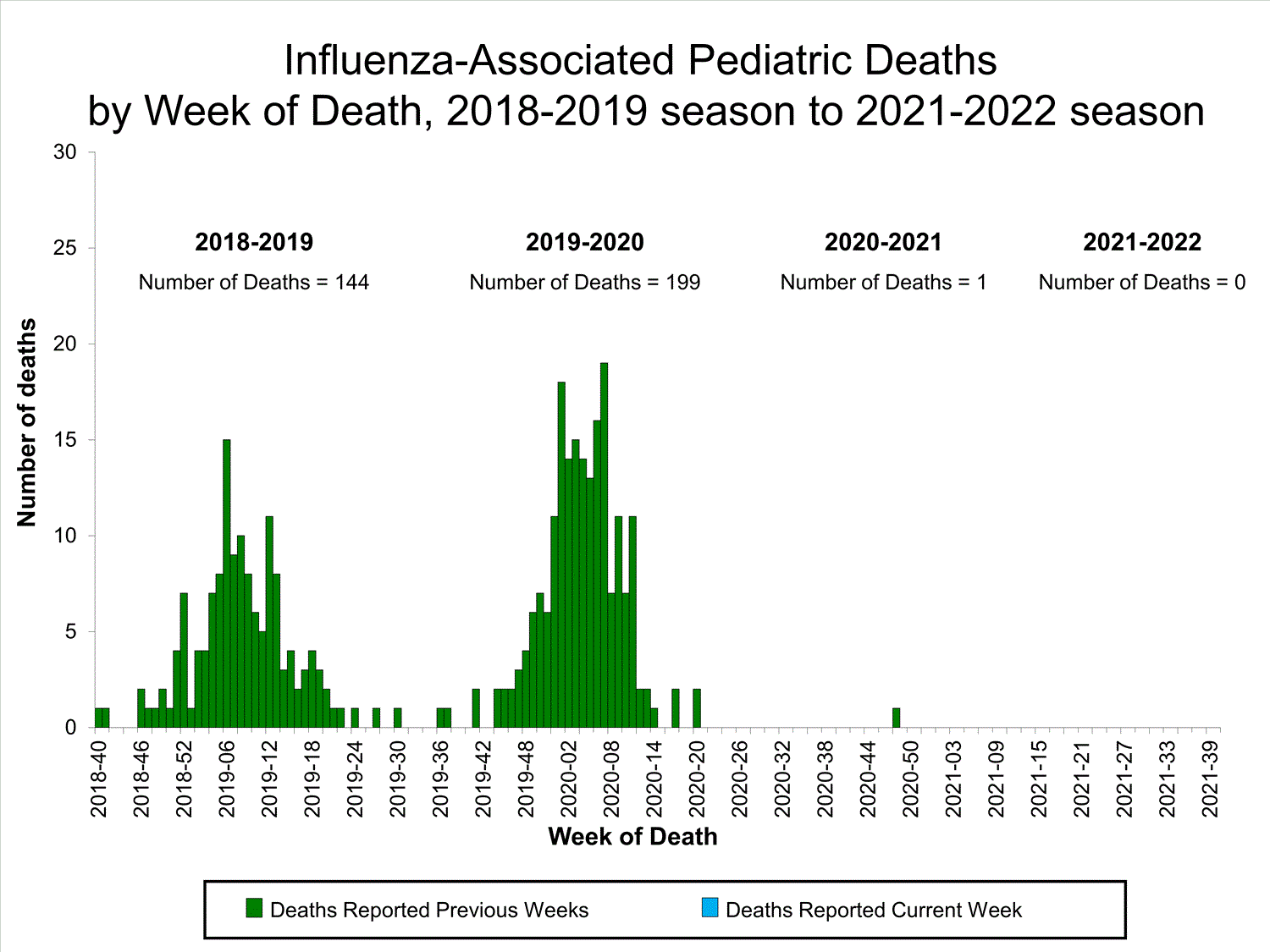
Additional pediatric mortality surveillance information for current and past seasons:
Surveillance Methods | FluView Interactive
Additional National and International Influenza Surveillance Information
FluView Interactive: FluView includes enhanced web-based interactive applications that can provide dynamic visuals of the influenza data collected and analyzed by CDC. These FluView Interactive applications allow people to create customized, visual interpretations of influenza data, as well as make comparisons across flu seasons, regions, age groups and a variety of other demographics.
National Institute for Occupational Safety and Health: Monthly surveillance data on the prevalence of health-related workplace absenteeism among full-time workers in the United States are available from NIOSH.
U.S. State and local influenza surveillance: Select a jurisdiction below to access the latest local influenza information.
World Health Organization:
Additional influenza surveillance information from participating WHO member nations is available through
FluNetexternal icon and the Global Epidemiology Reports.external icon
WHO Collaborating Centers for Influenza:
Australiaexternal icon, Chinaexternal icon, Japanexternal icon, the United Kingdomexternal icon, and the United States (CDC in Atlanta, Georgia)
Europe:
The most up-to-date influenza information from Europe is available from WHO/Europe and the European Centre for Disease Prevention and Controlexternal icon.
Public Health Agency of Canada:
The most up-to-date influenza information from Canada is available in Canada’s weekly FluWatch reportexternal icon.
Public Health England:
The most up-to-date influenza information from the United Kingdom is available from Public Health Englandexternal icon.
Any links provided to non-Federal organizations are provided solely as a service to our users. These links do not constitute an endorsement of these organizations or their programs by CDC or the Federal Government, and none should be inferred. CDC is not responsible for the content of the individual organization web pages found at these links.
A description of the CDC influenza surveillance system, including methodology and detailed descriptions of each data component is available on the surveillance methods page.

